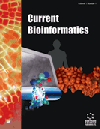-
oa Editorial[Hot Topic:Applications of Topological Indices and Complex Networks in Bioinformatics(Guest Editor: Humberto Gonzalez-Diaz)]
- Source: Current Bioinformatics, Volume 6, Issue 1, Mar 2011, p. 1 - 2
-
- 01 Mar 2011
Abstract
In the present days, there has been an explosion on the use of Topological Indices (TIs) described from graph theory to study Complex Networks on a broad spectrum of topics related to Bioinformatics and Proteomics. These topics cover many biomedical fields from Virology, Parasitology, and Microbiology in general to Toxicology, and Cancer research to cite only some of the more investigated. The main reason for this success of TIs, is the high flexibility of this theory to solve in a fast but rigorous way many apparently unrelated problems in all these disciplines. This determined the recent development of several interesting software and theoretical methods to handle with structure-function information and data mining in this field. In fact, recently, there has been an explosion on the use of TIs and Complex Networks on a broad spectrum of topics related to Bioinformatics but clearly differentiated from it. One important reason is that using TIs as inputs we can find Quantitative Structure-Property Relationships (QSPR) models for any kind of bio-systems; at least in principle. We see QSPR model as a function that predicts the properties of different systems using parameters that numerically describe the structure of the system (like TIs). We refer to almost any class of systems ranging from molecules to social networks such as: Drugs, Proteins and Proteomes, RNA, Diseasomes, Brain cortex Interactome, Disease spreading networks or Internet. There are many QSPR-like terms that fit to these and more specific situations, for instance Quantitative Structure-Activity Relationships (QSAR), Quantitative Structure-Toxicity Relationships (QSPR), Quantitative Proteome-Property Relationships (QPPR), Quantitative Sequence- Action Model (QSAM), or Quantitative Structure-Reactivity Relationships (QSRR), to cite a few examples. In all these cases we can find models that use the TIs of the system as input to predict the properties of this system (output). In any case, we miss a collection of manuscripts or issues focused on QSAR-like models with TIs and networks more focused on Bioinformatics. That is why; we have extended the discussion to a collection of authors guest-editing this special issue. Consequently, it is necessary to have a topic issue because many of the previous ones limit to a narrow field of application and ignore the several applications at different bioinformatics levels. On the other hand, many researchers, which move by the frontiers of these fields, miss the journal issues reviewing the actual applications and future perspectives of these software and methods and the possible relationships of data flow between them in a common theoretic framework. Such a collection of papers could be of major interest for many specialists on Bioinformatics and may increase the interchange between these specialists of different but related fields with a common root: proteomics and graph theory. In addition, it could be the seed for further improvement of software performance and compatibility. Taking into consideration all these aspects, this journal (Current Bioinformatics) presents this special issue composed of a collection of papers devoted to review the common theoretic basis, applications, and inter-connections between methods based on TIs and networks and their applications to Bioinformatics-related areas. We hope that the present issue may serve as a bridge between theoretical scientists in graph theory and experimentalists in order to suggest new areas of mutual interchange and collaboration. Based on all these reasons we edited the present issue including QSPR/QSAR studies as well as other types of studies using TIs and complex networks from the point of view of Bioinformatics but still including applications to related areas like Microbiology, Parasitology, Pharmacology, Chemoterapy, Epidemiology, Toxicology, and others. In this sense, the present issue provides state of the art reviews of some of these new computational approaches in this rapidly expanding area of Bioinformatics. Taking these aspects into consideration, in the first work of this issue Speck-Planche and Cordeiro focused on the role of Bioinformatics toward the design of compounds with anti-herpetic activity. In the second paper Chis et al. reviewed the state-of-art in yeast gene interaction networks studies and their own results. The authors of the third paper have presented here a work that reviews some bioinformatics concepts and previous studies related to Complex networks, GOs, and related methods that can be used for the study of CNP regions. In the next work of this issue, García et al. revised QSAR and other bioinformatics studies of GSK-3 inhibitory activity. On the other hand, Wan, Cai, Chou et al. reviewed previous models and introduced a new predictor called Sort-PLoc to tackle the difficult and challenging problem of protein subcellular localization prediction....


